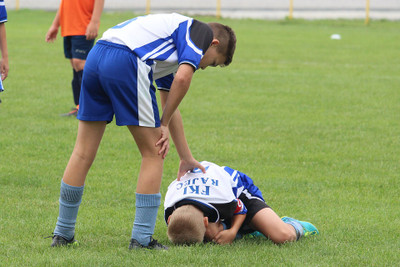 27th Sep 2021
27th Sep 2021
The Most Common Sports Injuries
Sports injuries sideline countless people the world over. While there is no guaranteed way to prevent these types of injuries, it is reassuring to know there are specific things you can do to minimize your risk significantly.
Fortunately, some of the most common sports injuries will respond well to rest and pain medication. However, some will also require immediate medical attention and a more intense recovery process.
Below are some of the most common sports injuries and all the basics you need to know about them.
Shin Splints
If you notice shooting pain down your front leg, you are likely dealing with shin splints. Shin splints can sometimes occur when there is a stress fracture in the bone. Shin splint injuries are common in runners and those who increase their exercise intensity too drastically.
A minor case of shin splints can be healed with rest, stretching, ice, and the use of proper footwear. If you have a severe case of the condition, it is recommended that you visit a medical professional to rule out stress fracture.
ACL Tear
The anterior cruciate ligament or ACL connects the thigh to the shinbone at the knee. Drastic movements like changing directions, stopping, or landing with a hard impact can strain or tear the ACL.
At times, ACL injuries are very severe and will require immediate medical attention. Some of the most common symptoms that point to ACL tear include swelling, intense pain, and cracking or popping noise.
Knee Injury
A whopping 55% of sports injuries occur in the knee. Knee injuries typically occur when the kneecap grinds against the leg bone repeatedly. This type of movement can damage the tissues of the kneecap and cause severe pain.
Sports that involve overhead movements are more susceptible to this type of injury. Those who play basketball, volleyball, swimming, baseball, and tennis are more prone to knee injuries.
If you suspect you have a knee injury, it is recommended that you have it checked by a medical professional immediately. Left unattended, it can sideline you permanently.
Tennis or Golf Elbow
Tennis elbow occurs when the tendon in the elbow degenerates because of repeated backhand strokes when playing tennis. Golf elbow occurs when the epicondyle is inflamed. It usually affects the inside of the elbow. Both injuries usually occur in athletes between 30 and 60 years old.
Initially, treating tennis or golf elbow will involve resting the injury. Ice and anti-inflammatory medications have also been known to help hasten the healing process. Usually, there are mechanical issues that can cause undue stress on the elbow.
Physical therapists can evaluate if you have tennis or golf elbow. They can also prescribe exercises that can correct the issue, so long-term problems are avoided.
Groin Pull
The muscles in the groin or inner thigh can help pull the legs together. Typically, a groin pull occurs when there is a sudden change in direction. Those who play soccer, hockey, football, and basketball are more prone to this type of injury. Some of the common symptoms of groin pull include swelling, bruising, and sharp pain on the inside of the thigh.
Hamstring Strain
The hamstring is located behind the knee and is made up of three muscles. Hamstring strains occur when the muscles are overstretched or overused. This kind of injury can be easily avoided by ensuring the muscles are not overused or overstretched.
Since walking can cause more stress on an injured hamstring, it can significantly prolong the healing time. Unfortunately, many athletes are at risk of injuring their hamstring since running is one of the primary causes of the condition. Common symptoms of hamstring strain include bruising and pain.
Sciatica
Pain that is felt anywhere on the sciatic nerve path is referred to as sciatica. The sciatic nerve branches from the lower back through the buttocks and hips and down each leg. Sciatica is often caused by improper stretching. This type of injury typically affects only one side of the body.
Athletes who participate in running, tennis, golf, and cycling suffer from sciatica. Bulging disks and sciatica will require immediate medical attention. The help of a physical therapist is also needed to help resolve this condition.
Hip Flexor Strain
The group of muscles that help in the upward movement of the knee or leg is known as the hip flexor. Hip flexor strain occurs when the hip flexor muscles are stretched too far or torn. The condition is common among athletes involved in sports that include drastic direction changes or sudden upward movements.
People who participate in soccer, football, hockey, and martial arts are prone to hip flexor strain. A minor case of hip flexor strain will respond well to rest, ice, and pain medications. A physical therapist may also recommend hip-strengthening exercises.
Final Thought
It is recommended that you visit the doctor right away if the injury causes extreme swelling, bruising, or pain. If there is an obvious deformity, visiting a doctor is considered ideal. Apart from medications, you might also need to use a splint or sling to help you heal faster.
About the Author
Dr. Charles R. Kaelin received his medical degree from the University of Louisville, Kentucky, and completed his orthopaedic training at Orlando Regional Center in Orlando, Florida. Dr. Kaelin also received training in Sports Medicine at Alabama Sports Medicine with Dr. Lemak, specializing in sports medicine and workman's compensation injuries. He has been a fellow of the American Academy of Orthopaedic Surgeons (AAOS) since 1990. He is a charter member of the International Cartilage Research Society, Founding member of the AAOS Education Enhancement Fund (AAOS) and past editorial board member for the American College of Sports Medicine Health and Fitness Journal.





